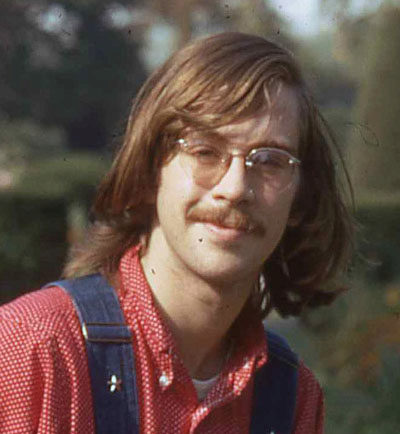Tom DeFanti featured in OSU’s Buckeye Blog Newsletter
May 21st, 2010

About
Spring 2010 - The article “Tom DeFanti: Computer Graphics Pioneer” appears in the Spring 2010 issue of the Buckeye Blog newsletter, published by the Computer Science and Engineering (CSE) department of Ohio State University (OSU). The article features OSU / CSE alumnus DeFanti, who in 1973 received his PhD and moved to the University of Illinois at Chicago (UIC) as an assistant professor of computer science. At that time, with art professor Dan Sandin, they created the UIC Electronic Visualization Laboratory (EVL) - which 37 years later is still quite well and thriving. This article profiles DeFanti’s storied career, listing many highlights from his years at EVL, his subsequent move to Calit2 at University of California, San Diego (UCSD) in 2005, and his current achievements. The complete article appears below; upload the complete Buckeye Blog newsletter.
Reprinted from Buckeye Blog, Spring 2010, published by the Computer Science and Engineering (CSE) department of Ohio State University (OSU), Featured Alumni section, page 6.
TOM DeFANTI: COMPUTER GRAPHICS PIONEER
At age 24, with his OSU / CSE doctoral degree in hand, thanks to an OSU fellowship and a research assistantship in Prof. Charles Csuri’s Computer Graphics Research Lab, Tom DeFanti moved to the University of Illinois at Chicago (UIC) in 1973 as an assistant professor of computer science and set up, with Dan Sandin, the Electronic Visualization Laboratory (EVL) - which 37 years later is still quite well and thriving. In 1976, Tom helped computer animation pioneer Larry Cuba create the computer graphics for the 1977 movie Star Wars (using the same graphics language he developed for his PhD). In 1977, Tom became secretary of the ACM / SIGGRAPH organization, as well as becoming active in working on and growing its annual conference from hundreds to thousands of attendees. He was tenured in 1978 and promoted to associate professor. In 1978, he began doing R&D for Bally / Midway, the maker of PacMan and Space Invaders in the US and created the operating system and programming language of one of the first “personal computers” (the Bally Home Library Computer), which later got produced as the Datamax UV-1, a system popular with digital video artists for many years. Tom became chair of the SIGGRAPH organization from 1981-1985 and proactively led its expansion with its fast-growing annual conference, SIGGRAPH Video Review publication, and many international alliances. Tom is also a Fellow of the Association for Computing Machinery and the 1988 recipient of the ACM Outstanding Contribution Award.
In 1986, Tom married Kathy Tanaka and later had sons Ian (1987) and Connor (1992). Also in 1986, Tom started his long association with Dr. Larry Smarr of the National Center for Supercomputing Applications at the University of Illinois at Urbana-Champaign. Tom shortly thereafter hired Maxine Brown to be EVL associate director, who, with Larry’s guidance, propelled EVL from a very modest lab to the best-funded lab at UIC for many years. The affiliation with Larry led Tom, along with Maxine and Bruce McCormick of TAMU, to edit the acclaimed 1987 report for the National Science Foundation entitled “Visualization in Scientific Computing.” Another high point was SIGGRAPH’92, which Maxine chaired, a 35,000-person conference in Chicago that brought for the first time, under Tom’s leadership, 45Mb/s networking to a SIGGRAPH conference. Also debuting at that conference was the CAVE™ virtual reality system, conceived by Tom and Dan. Trying to extend the idea of videoconferencing, then just in its infancy, to 3D (that is, CAVE-to-CAVE) communications, led Tom and Maxine to get involved with high-speed networking. At SC’95 in San Diego, Tom, assisted by Maxine, organized the I-WAY event, which showcased over 60 US collaborations (and 1 Canadian) that required advanced networking to do scientific computing. Based on the success of SC’95, Tom and Maxine submitted an unsolicited proposal to NSF to build STAR TAP, an international advanced networking exchange “hub” in Chicago for research and education networks. Started in 1997, it continues its growth as StarLight, managed by close colleague Joe Mambretti at Northwestern University, and has become the largest such exchange in the world, and is a model for building such exchanges in many countries that form the Global Lambda Integrated Facility (GLIF).
For almost 20 years, Tom, Dan, Greg Dawe, and current EVL director Jason Leigh built and networked CAVEs and then started creating huge tiled LCD panels, building a 100-megapixel tiled display in 2004. Larry had since moved to University of California, San Diego (UCSD) in 2000 and became founding director of the California Institute for Telecommunications and Information Technology (Calit2). Together, Larry and others from UCSD, as well as Tom, Maxine and Jason at UIC, successfully got $13.5M of NSF funding in 2002 for the 7-year OptIPuter project to build a global network-based computer. In 2004, Tom, as a UIC distinguished professor, achieved emeritus status and moved to Del Mar, California, to become a research scientist at Calit2, bringing Kathy, Ian, and Connor. Greg also moved to San Diego and works at Calit2, and Dan is a frequent visitor and consultant.
At Calit2, between 2005 and 2007, Tom and Greg built the StarCAVE, a 34-projector CAVE, and an 80-megapixel version of Dan Sandin’s Varrier Autostereo virtual reality display. Tom’s latest projects include GreenLight (an NSF-funded instrument to measure power usage for GPU, FPGA, and conventional computing architectures), KAUST’s advanced visualization research facilities, and CineGrid (providing means to transmit and archive digital motion pictures). Tom, Dan, Maxine, Greg, Larry, Jason, and Joe, along with new faculty, researchers and students at UIC and UCSD, work together every day, using and extending the transformative capabilities of cyberinfrastructure.